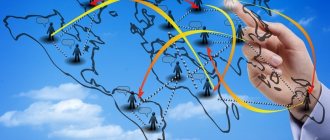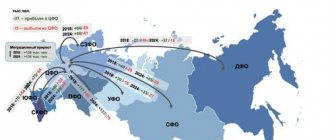Classification of migrations
Let's look at the table that presents the classification of migrations.
| Types of migrations by characteristics | Types of migrations |
| Geographical characteristics | External |
| Internal | |
| Reasons (goals) | Economic |
| Political | |
| Religious | |
| Family | |
| Departure from places of natural and industrial disasters | |
| Duration | Constant |
| Temporary | |
| Legal Compliance | Legal |
| Illegal | |
| Degree of coercion | Voluntary |
| Forced |
Types of migrations can belong to several types of migrations. For example, internal migrations have all the characteristics listed in the first column.
Migration concept
Definition 1
Migration is the process of changing permanent place of residence, relocation, movement of people or social groups to another region, geographic area or country for a period of at least six months.
Migration is also understood as one of the forms of population movement, in which a change in place of residence for a significant time and distance is accompanied by significant social, economic, political, demographic consequences (explicit and hidden, positive and negative, current and long-term, etc.).
Migration processes are based on reasons of various natures: political, economic, national, social, religious, etc.
Migrants are persons who voluntarily or involuntarily change their previous territoriality. They are largely subject to marginalization due to the loss of their “territorial roots.” Attachment to a specific place of life greatly affects a person’s mental and somatic health, the sense of ownership, his ethics, the sense of internal space, and the perception of nature. All this gives rise to problems of family, procreation, and ethnicity.
Help with student work on the topic Migration and its types
Coursework 480 ₽ Essay 260 ₽ Test paper 190 ₽
Get completed work or consultation with a specialist on your educational project Find out the cost
Migration processes can be forced or natural.
The migration process is closely related to mobility (horizontal and vertical), since any migrating individual, in addition to joining a new social group, wants to find better political, economic or social conditions. Population migration is spatial mobility.
In migration processes, intra-settlement and inter-settlement movements are distinguished. In the classical understanding of migration, it includes inter-settlement movements, since they change the picture of population distribution in the region, country, and world.
Definition 2
Inter-settlement movement is a set of inter-settlement movements, i.e. territorial movements of individuals or social groups between settlements, regions, countries, of any duration, not related to or related to work activities.
Depending on the regularity and duration, intersettlement movement has irrevocable (population migration itself) and return (other types of migration) forms.
Looking for ideas for study work on this subject? Ask a question to the teacher and get an answer in 15 minutes! Ask a Question
Geographical characteristics
External ones include emigration (leaving the country), immigration (entry), re-emigration (return after emigration), repatriation (return to the homeland).
Moving for any purpose within the country can be considered internal. For example, nomadic peoples constantly move in search of pastures and hunting grounds.
Rice. 1. Nomads.
External population migrations
This is the movement of people from one country to another, both temporary and permanent: emigration - entry into a state for permanent residence, immigration - departure from it. Western Europe is characterized by external pendulum migrations. People who live in one country and commute daily to work in another are called frontiers . Factors pushing people to move are:
- extreme instability
- economic crisis or conflict,
- demographic changes,
- economic development,
- advances in communication technologies,
- access to means of transportation.
In many countries of the world, as a result of external migrations, ethnic diasporas - (from the Greek “dispersion”) - part of the people living outside the country of their residence. The largest diasporas include groups of Germans, Chinese, Irish, Jews, Italians, Poles, Russians, and Vietnamese.
Forced external migrations
Forced and forced migrations under the influence of orders from the military, civil administration or under the pressure of external circumstances are called forced. A significant part of migrants in our time are refugees and re-emigrants. People are fleeing from man-made accidents, military conflicts, natural disasters, climate change, changes in the political system, human rights violations, etc.
Forced migrations include:
- export of slaves, for example, from Africa, first to Europe (since 1441), then to America. In total, from Africa in the 16th-19th centuries. about 100 million people were deported;
- expulsion of colonists, for example, after India gained independence, 1.5 million Englishmen had to leave it. Russians also left the former republics of the USSR;
- Refugees from wars and conflicts are leaving countries; more than 6 million people have left Afghanistan. After the formation of the State of Israel, a significant part of the Arab Palestinians left the country;
- the forced deportation to Germany of 9-10 million people from the countries it occupied during the Second World War;
- political emigrants (“political emigrants”) are hiding abroad from persecution by the authorities. For example, almost half a million citizens emigrated from Nazi Germany, these were mainly intellectuals (Albert Einstein, Enrico Fermi, Lion Feuchtwanger, etc.). They also fled from Italy and Francoist Spain, from Chile during the time of Pinochet, revolutionary Russia, Cuba, Cambodia, Vietnam, etc.
Voluntary external migrations of the population
People voluntarily go to work and explore new lands, in search of a better life. Seasonal migrations are associated with short-term departures from the country - for work, study, treatment, etc. Every year, several million Mexicans travel to the United States for agricultural work, millions of Ceylonese, Pakistanis, and Indians are contracted to work in oil-exporting countries of the Middle East, etc.
Seasonal migrations also include such types of migration as pilgrimages to holy places and nomadism. International tourism is considered by some scientists and politicians to be a special type of episodic migration, while others do not consider it to be migration at all.
People go to work mainly from countries where unemployment is high, there is a surplus of labor and low wages. These include resettlement migrations. The predominant types of external voluntary migrations have changed historically:
- to countries with undeveloped territories. More than 20 million such migrants came from Great Britain, Italy, Spain, Germany, France, Russia, Ireland, Scandinavian countries, and Poland. People traveled to the USA, Canada, Argentina, Brazil, Australia, South Africa, and New Zealand. Descendants of German immigrants make up the largest ethnic community in the United States - 65.5 million people, in Brazil the descendants of Italian immigrants predominate - 24 million, in Argentina - 14.5 million.
- in the 19th century, the mass hiring of Chinese and Indian farm laborers (coolies) to work on plantations, etc. became widespread. Now the total number of descendants of Chinese farm laborers in the world amounts to more than 50 million people (this phenomenon is called “huaqiao” or “bridge to the Chinese shore "), Indian - 11 million people. Most Chinese live in the countries of Southeast Asia, Indians live in Southeast Asia, South Africa, Mauritius, Trinidad and Tobago, Guyana and Fiji.
- In the second half of the 20th century, external migration changed. The number of emigrants from European countries to America has decreased, intra-European migration has become active (from less developed countries to more developed ones), but especially many people are moving from developing countries around the world to developed ones.
- since 1970, a flow of migrants began to the oil-producing countries of the Persian Gulf, Libya, etc. The share of labor migrants in the total workforce in the mid-1990s. was: in Australia - 25%, in Canada - about 20%, in the USA and Germany - about 10%.
Migrations of the working population
"Brain drain"
At the turn of the 20th-21st centuries, the share of “muscles” (people engaged in physical labor) among migrants decreased and the share of “brains” increased. If in 1970 the share of people engaged in mental work was 10%, then in 2010 it reached 40%. Brain drain is most noticeable in developing countries such as India, Brazil, the Philippines and in post-socialist countries - Russia, Ukraine, etc.
The migration of intellectuals took place in several stages, developing in “co-evolution” with the scientific and technological revolution and changes in the political arena.
- After the end of World War II, thousands of specialists in the field of rocket science, physics, etc. were voluntarily and forcibly exported from Germany to the United States.
- In the 50s of the 20th century, the migration of talents took place from some developed countries to others. From Germany, Italy, Great Britain, and to a lesser extent from France, university graduates and scientists left for the USA, Australia and Canada. At this time, the United States gained at least 100 thousand specialists, and European countries suffered significant losses in this regard.
- In the 60-80s of the XX century. intellectuals migrated from developing to developed countries. Most of the talent came from Asia, but there were also flows from Latin America and Africa. About 800 thousand programmers, scientists, medical personnel, doctors, engineers and young specialists who had just completed their studies moved to the USA, Canada, Great Britain and Australia only in the 60-70s. The greatest intellectual and financial losses were suffered by India (doctors and engineers), the Philippines (nurses), China, Egypt, the countries of the West Indies, the Republic of Korea, Algeria, and Nigeria. According to UN estimates, the financial losses of developing countries over 30 years amounted to more than $60 billion.
- From the late 80s of the 20th century to the present day, an active “brain drain” has occurred primarily from post-socialist countries. Scientists, entrepreneurs, and technical specialists leave for the USA, Germany, Canada, Israel and other countries.
“Brain drain” is a type of labor migration, the reasons for which can be different:
- economic advantages that intellectual migrants acquire in the host country. For example, Filipino nurses in their country can expect a monthly salary of $150, while in the United States their salary can be $2,500 per month;
- inability to find work in your specialty and realize your potential in your home country;
- social;
- racial-ethnic;
- political.
The USA has been and remains the center of attraction for intellectuals; it attracts 2/3 of their total number. They have incentive immigration laws, especially for highly skilled professionals. In this way, they save on education, because their own training costs are very high.
It has been noted more than once that over the 100 years of the Nobel Prize's existence, approximately 400 people have become laureates, half of whom were in the United States. But many of the American laureates are emigrants, including first-generation ones (for example, world-famous economists who came from Russia - S. Kuznets and V. Leontyev).
In the 90s, Russia became one of the main suppliers of intellectual personnel for foreign developed countries. Hundreds of thousands of educated, enterprising people and promising youth left the country. A type of “brain drain” in Russia also includes those people who did not go abroad, but moved from education and science to business and management. This trend continues today, and low salaries of scientists and teachers contribute to the intellectual degradation of our education and science.
Such an outflow of scientists and specialists from the country not only causes enormous material damage to it, but also impoverishes its intellectual potential, thereby creating a real threat to national security.
Illegal population migrations
Regarding legal registration, all migrations are divided into legal and illegal. Due to unaccounted for underground movements, statistical calculation of real migrants is difficult. Fighting this phenomenon is not beneficial for either the receiving or issuing side. Countries that admit illegal immigrants receive an additional source of cheap labor, and those sending them are happy to find employment for some portion of their unemployed.
Illegal migration of the population began to actively increase since the 1970s; in the 1990s, there were about 30 million migrants without appropriate registration and permission. In general, the growth of this indicator indicates a sharp polarization of countries into poor and rich.
In Russia and Foreign Europe, only migration ensures population growth; its share in total growth is 87%, and natural growth is only 13%. Illegal movement of people leads to population decline in the countries of Asia, Latin America and Africa.
Reasons for migration
The most common reason is economic, that is, moving to areas where work or higher earnings are offered. This species is typical for Russia.
Political migrations are caused by a violent change of power, military actions, and the expulsion of oppositionists from the country. The scale of this type of migration can be unpredictable. Thus, in 2015, about 1 million refugees from Africa and the Middle East migrated to Germany.
A pilgrimage is an example of religious trips to shrines of different faiths.
Rice. 2. Pilgrims on Mount Arafat, outskirts of Mecca.
The purpose of family migration is the reunification of families - children and parents, spouses.
Natural and industrial disasters cause migration of population groups from dangerous areas to areas proposed by the authorities or chosen independently.
Concept and types of population migrations
The total population of the country and its regions depends not only on the natural, but also on the mechanical movement of the population - migrations .
The term “migration” of the population comes from Lat. migration - to move.
When studying migration processes, various quantitative indicators can be used. For example, the scale of migration (migration turnover) is the number of arrivals and departures to an area over a certain period of time (year). The difference between the number of arrivals and departures is called the migration balance. It can be positive (mechanical increase) and negative (mechanical population decline).
For example, in 2004, 120 thousand people arrived in the Moscow region, and 63 thousand left. The scale of migration (migration turnover) is 120 + 63 = 183 thousand people. Balance of migration: 120 - 63 = +57 thousand people.
Migration is a complex social process of territorial mobility of the population. It is closely related to changes in the economy, the location of production, and uneven quality of life.
There are different types of migration : by direction, by time.
Table 1. Types of migration by direction
| Types of migration by direction | |
| ↓ | ↓ |
| Internal: | External: |
| internal population movement | movement of populations between countries and continents |
The migration flow coming from a country is called emigration , and people leaving it are called emigrants. The flow of migration entering a country is immigration , and those arriving are immigrants.
Internal migrations , in turn, include inter-district, intra-district, movements between villages, between cities or between cities and villages (Table 2).
Table 2. Internal migrations
| Types of internal migrations | ||
| ↓ | ↓ | ↓ |
| Interdistrict: | Intradistrict: | Intersettlement: |
| movement of population between regions, republics, subjects of the country | movement of population within one region, republic, subject of the country | population movement according to the following schemes:
|
Based on time characteristics, the following migrations are distinguished: Material from the site https://doklad-referat.ru
- permanent (irrevocable) - final change of residence;
- temporary - relocation for a long but limited period (work under a contract for several years);
- seasonal - movement of people in certain seasons (in summer - to resort areas);
- pendulum - regular trips to a place of work or study outside of your locality.
of the reasons for migration plays an important role , the main ones being:
- economic - for example, moving to areas with a higher standard of living;
- socio-political - political emigration, relocation based on national or religious motives;
- military - for example, evacuation of the population from a theater of military operations;
- environmental - leaving the zone of environmental disaster.
The modern demographic picture has developed largely due to migration processes.
Migration is an important phenomenon associated with the territorial mobility of the population. Internal and external migrations affect the population and its demographic structure (fertility, mortality, natural increase), as well as the level of population of regions. In the process of migration, problems arise of biological, social and ethnic adaptation to new living conditions.
On this page there is material on the following topics:
Presentation of the concept of migration, its consequences, abstract
What types of migration would you classify spring and summer as?
Basic concepts on the topic of external migrations
Report on the topic of population migration
What types of mishration affect the number
Questions about this material:
How do migrations affect the demographic situation?
What types of spring-summer migration of city dwellers to the countryside are included?
What demographic consequences does rural-urban migration have?
Duration
Based on duration, migrations are divided into permanent, without returning to their previous place of stay, and temporary. Temporary ones can be long-term (more than 1 year) and short-term (less than 1 year). These are business trips, work shifts, daily trips to work and school (pendulum).
Rice. 3. Bike to school.
In Russia, rotational work in the Arctic provides the necessary influx of labor resources for oil and gas production, and maintenance of military bases.
Legal status
According to its legal status, migration can be legal or illegal. The first assumes that migrants move to other countries on the basis of entry documents, obtain immigration status there, and end up legally present in the territory of those states. This category of migrants is submitted to the statistical records of immigration authorities, and the process itself is largely regulated by the state. An example of state regulation of migration processes can be the introduction of quotas in many countries of the European Union regarding the admission of migrants, as well as the creation of special immigration programs designed to attract certain categories of foreign citizens to the country.
Illegal migration is a huge problem for economically developed countries. According to experts, in the United States of America alone there will be more than 10 million illegal migrants in 2021. The legislation against illegal immigrants is constantly being tightened, the police are fighting against them, but the number of illegal immigrants in the world continues to grow.
In particular, foreigners who arrive in a certain state are considered illegal migrants:
- with false documents;
- by illegally crossing the state border;
- remains on the territory of the country after the period of permits limiting the period of his stay in this state has expired.
All illegal migrants are, to one degree or another, a threat to the society and economy of the host country. This leads to an increase in social tension in its society, an increase in the unemployment rate among the local working population, the creation of chaos in the domestic labor market, as well as the outflow of funds abroad.
Americans are trying to protect themselves from Mexican illegal migrants with a huge wall
Law and coercion
Countries have immigration laws. The migrant must submit an application of a certain form to the migration department and receive permission to enter or reside in the country. This is an option for legal migration. If a citizen has arrived or is in the country without permission, he is considered an illegal migrant. During the migration crisis, criminal schemes were developed to smuggle refugees into EU countries. At the same time, some of the refugees died on the way.
Voluntary migration means moving or traveling at your own request (on vacation, to study, to a new place of residence), forced migration occurs by decision of law enforcement agencies or military command, during deportation from occupied areas, etc.
Migration mechanisms
People are forced to change their usual place of residence as a result of certain conditions:
- Pushing out. Occurs when the living conditions of an individual in his native place become difficult or unsatisfactory. The expulsion of large groups of people is associated with economic crises, severe social upheavals (wars, dictatorships, ethnic conflicts), natural disasters (floods, earthquakes, etc.). The pushing force for individual migration can be the death of relatives, career failures, loneliness, etc.
- Attraction. It is characterized by a complex of attractive conditions and features for living in other places (higher wages, greater political stability, the opportunity to obtain a higher social status). The greater the difference in the economic, social and political conditions of life in the two territories, the more likely the processes of migration to areas with better living conditions are. Attraction can be created artificially to attract “mind” and labor.
- Migration routes. Directly characterize the movement of a migrant from one place to another. Includes the accessibility of the migrant, his family, and belongings to another region; absence or presence of barriers along the way; information to help overcome financial difficulties.
Do you need to select scientific articles for your academic work? Specify a topic and receive a response in 15 minutes get help
Test on the topic
- Question 1 of 5
What type of migration describes the movements of nomads?
Start test (new tab)
Hall of Fame
To get here, take the test.
-
- Gulkayir Zhailoobekova
5/5
- Galina Konopleva
5/5
- Lyubov Zharkova
5/5










